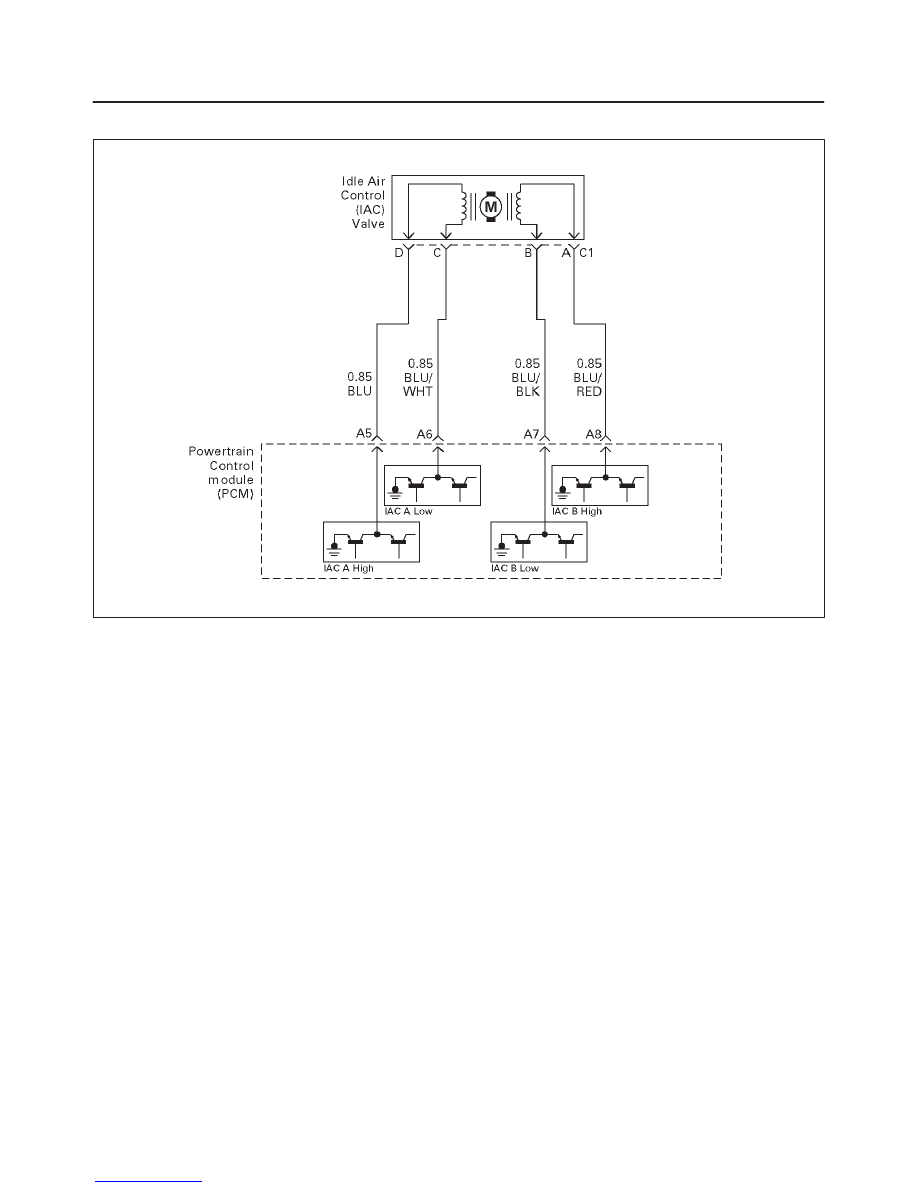Isuzu Rodeo UE. Manual — part 413

6E2–407
RODEO 6VD1 3.2L ENGINE DRIVEABILITY AND EMISSIONS
DTC P1508 –IAC System Low RPM
(Cont'd)
Step
No
Yes
Value(s)
Action
5
Visually/physically inspect for following conditions:
f
Restricted air intake system. Check for a possible
collapsed air intake duct, restricted air filter
element, or foreign objects blocking the air intake
system.
f
Throttle body. Check for objects blocking the IAC
passage or throttle bore, excessive deposits in
the IAC passage and on the IAC pintle, and
excessive deposits in the throttle bore and on the
throttle plate.
Do any of the above require a repair?
—
Refer to
appropriate
section for
on-vehicle
service
Go to
Step 6
6
1. Check for a poor connection at the IAC harness
connector.
2. If a problem is found, replace faulty terminals as
necessary.
Was a problem found?
—
Verify repair
Go to
Step 7
7
Replace the IAC valve.
Is the action complete?
—
Verify repair
—
8
Replace the PCM.
IMPORTANT: The replacement PCM must be
programmed. Refer to
On-Vehicle Service in
Powertrain Control Module and Sensors for
procedures.
And also refer to latest service bulletin
Check to see if the Latest software is released or not.
And then Down Load the LATEST PROGRAMMED
SOFTWARE to the replacement PCM.
Is the action complete?
—
Verify repair
—

6E2–408
RODEO 6VD1 3.2L ENGINE DRIVEABILITY AND EMISSIONS
Diagnostic Trouble Code (DTC) P1509 IAC System High RPM
T321115
Circuit Description
The powertrain control module (PCM) controls engine
idle speed by adjusting the position of the idle air control
(IAC) motor pintle. The IAC is a bi-directional stepper
motor driven by two coils. The PCM applies current to the
IAC coils in steps (counts) to extend the IAC pintle into a
passage in the throttle body to decrease air flow. The
PCM reverses the current to retract the pintle, increasing
air flow. This method allows highly accurate control of idle
speed and quick response to changes in engine load. If
the PCM detect a condition where too high of an idle
speed is present and the PCM is unable to adjust idle
speed by increasing the IAC counts, DTC P1509 will set,
indicating a problem with the idle control system.
Conditions for Setting the DTC
f
No Tech 2 test is being run.
f
None of these DTCs are set: TP sensor, VSS, ECT,
EGR, fuel system, MAF, MAP, IAT, canister purge,
injector control or ignition control.
f
Barometric pressure is above 75 kPa.
f
Engine coolant temperature is above 50
°
C (120
°
F).
f
Engine speed is more than 100-200 RPM higher than
desired idle, based upon coolant temperature.
f
The engine has been running for at least 125 seconds.
f
Vehicle speed is less than 1 mph.
f
Canister purge duty cycle is above 10%.
f
Ignition voltage is between 9.5 volts and 16.7 volts.
f
Engine speed is higher than desired idle.
f
All of the above conditions are met for 5 seconds.
Action Taken When the DTC Sets
f
The PCM will illuminate the malfunction indicator lamp
(MIL) after the second consecutive trip in which the
fault is detected.
f
The PCM will store conditions which were present
when the DTC was set as Freeze Frame and in the
Failure Records data.
Conditions for Clearing the MIL/DTC
f
The PCM will turn the MIL “OFF” on the third
consecutive trip cycle during which the diagnostic has
been run and the fault condition is no longer present.
f
A history DTC P1509 will clear after 40 consecutive
warm-up cycles have occurred without a fault.
f
DTC P1509 can be cleared by using the Tech 2 “Clear
Info” function or by disconnecting the PCM battery
feed.
Diagnostic Aids
Check for the following conditions:
f
Poor connection at PCM or IAC motor – Inspect
harness connectors for backed-out terminals,
improper mating, broken locks, improperly formed or
damaged terminals, and poor terminal-to-wire
connection.
f
Damaged harness – Inspect the wiring for damage.
f
Vacuum leak – Check for a condition that causes a
vacuum leak, such as disconnected or damaged
hoses, leaks at the EGR valve and the EGR pipe to the

6E2–409
RODEO 6VD1 3.2L ENGINE DRIVEABILITY AND EMISSIONS
intake manifold, leaks at the throttle body, faulty or
incorrectly installed PCV valve, leaks at the intake
manifold, etc.
f
Throttle body – Check for sticking throttle plate. Also
inspect the IAC passage for deposits or objects which
keep the IAC pintle from fully extending.
Reviewing the Failure Records vehicle mileage since the
diagnostic test last failed may help determine how often
the condition that caused the DTC to be set occurs. This
may assist in diagnosing the condition.
DTC P1509 –IAC System High RPM
Step
Action
Value(s)
Yes
No
1
Was the “On-Board Diagnostic (OBD) System Check”
performed?
—
Go to
Step 2
Go to
OBD
System
Check
2
1. Start the engine.
2. Turn all accessories “OFF” (A/C, rear defroster,
etc.).
3. Using a Tech 2, command RPM up to 1500, down to
500, and then up to 1500 while monitoring “Engine
Speed” on the Tech 2.
NOTE: This Tech 2 command may cause the engine to
“cut out” when RPM goes above 1500. If this occurs,
the “cutting out” will stop when the Tech 2 command for
the test is discontinued, or if the Tech 2 command is
changed to less than 1500 RPM.
Does the “Engine Speed” remain within the specified
value of “Desired Idle” for each RPM command?
±
50 RPM
No trouble
found. Go to
Diagnostic
Aids
Go to
Step 3
3
1. Disconnect the IAC.
2. Install IAC Noid Light J 37027 or equivalent.
3. With the engine running, command RPM up to
1500, down to 500, and then up to 1500 while
observing the noid light.
NOTE: This Tech 2 command may cause the engine to
“cut out” when RPM goes above 1500. If this occurs,
the “cutting out” will stop when the Tech 2 command for
the test is discontinued, or if the Tech 2 command is
changed to less than 1500 RPM.
Does each noid light cycle red and green (never
“OFF”)?
—
Go to
Step 5
Go to
Step 4
4
1. Check the following circuits for an open, short to
voltage, short ground, or poor connections at the
PCM:
f
IAC “A” Low.
f
IAC “A” High.
f
IAC “B” Low.
f
IAC “B” High.
2. If a problem its found, repair as necessary.
Was a problem found?
—
Verify repair
Go to
Step 8
5
Visually/physically inspect for the following conditions:
f
Vacuum leaks.
f
Throttle plate or throttle shaft for binding.
f
Accelerator and cruise control cables for being
misadjusted or for binding.
f
Faulty, missing, or incorrectly installed PCV
valve.
Do any of the above require a repair?
—
Refer to
appropriate
section for
on-vehicle
service
Go to
Step 6

6E2–410
RODEO 6VD1 3.2L ENGINE DRIVEABILITY AND EMISSIONS
DTC P1509 –IAC System High RPM
(Cont'd)
Step
No
Yes
Value(s)
Action
6
1. Check for a poor connection at the IAC harness
connector.
2. If a problem is found, replace faulty terminals as
necessary.
Was a problem found?
—
Verify repair
Go to
Step 7
7
Replace the IAC valve.
Is the action complete?
—
Verify repair
—
8
Replace the PCM.
IMPORTANT: The replacement PCM must be
programmed, Refer to
On-Vehicle Service in
Powertrain Control Module and Sensors for
procedures.
And also refer to latest service bulletin
Check to see if the Latest software is released or not.
And then Down Load the LATEST PROGRAMMED
SOFTWARE to the replacement PCM.
Is the action complete?
—
Verify repair
—

Нет комментариевНе стесняйтесь поделиться с нами вашим ценным мнением.
Текст